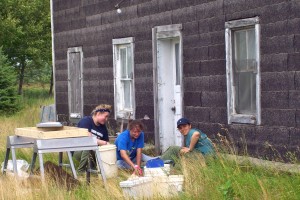Deb Rotman, Ph.D., RPA
Department of Anthropology
University of Notre Dame
drotman@nd.edu
Beaver Island is an incredibly fascinating location for nineteenth-century Irish immigration. We hope to secure grant funding and return to the island SOON!
Project Summary
This archaeological and historical project allows scholars and students to investigate an aspect of the Irish Diaspora that is currently virtually unknown – that is, the lived experiences of Irish immigrants who settled away from the large urban centers on the East Coast. Importantly, however, this project is also an opportunity for students to receive training in archaeological field and laboratory methods  as well as engage in professional development activities through their own research projects. A key element of the project is involving the local community in this public archaeology project by including them in the field excavation, laboratory processing and analyses, scholarly lectures, as contributors of oral histories, and as participants in the Project Archaeology workshop.
as well as engage in professional development activities through their own research projects. A key element of the project is involving the local community in this public archaeology project by including them in the field excavation, laboratory processing and analyses, scholarly lectures, as contributors of oral histories, and as participants in the Project Archaeology workshop.
Millions of Irish people left their homeland in the 18th through the 20th centuries and emigrated to the United States, the United Kingdom, Australia, Argentina, and countless other places around the world. Since 2006, my students and I have been investigating Irish immigrant experiences in South Bend, Indiana, including archaeological excavation in the city as well as archival research and oral history collection in both Ireland and the United States. Beginning in 2010, this project expanded to include Beaver Island, Michigan, which was inhabited in the late nineteenth century by immigrants from Árainn Mhór off the coast of Co. Donegal.
At present, the lives of Irish immigrants to America are understood almost exclusively through investigations of large urban centers like Boston and New York. Smaller communities in the Midwest, such as South Bend (1865-1920) and Beaver Island (1856-1903), however, had economic, social, and political structures that were more fluid than those of the long-established urban enclaves on the East Coast and offered different opportunities to immigrants. Consequently, archaeological and historical investigation of these smaller and more isolated communities will contribute significantly to our understanding of the Irish Diaspora in America by elucidating lived experiences in small towns and rural fishing villages not previously explored.
